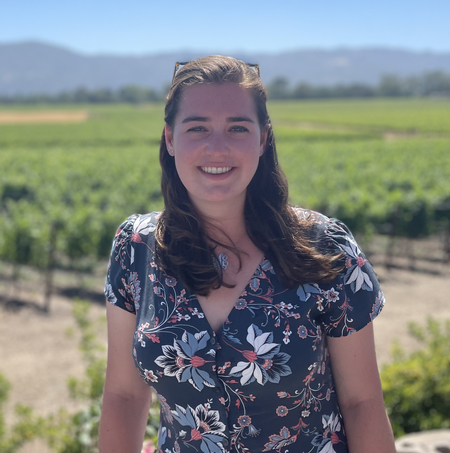Q & A with the Expert
It's Cooler in the Shade
the what, when, why, and how to use vineyard shade netting
Edited by Christopher Chen
Guest - Lauren Marigliano

Question:
When using nets that reduce the transmissivity of specific wavelengths of light, which wavelength was most beneficial when reduced by the nets/shades?
Answer:
“When using shade nets to protect grape clusters from sunburn and heat exposure, it has been shown that reducing near-infrared radiation (NIR) is the most beneficial for improving berry secondary metabolite composition. NIR is the wavelength of solar radiation that is responsible for the heat that reaches the earth. As such, by reducing the amount of NIR that is available to the grape clusters, there is a reduction in berry temperature. Black shade nets applied to the sides of the canopy are most effective at reducing cluster temperatures when compared to uncovered vines, ultimately reducing temperatures by 3.7ºC on the afternoon side of VSP-trained grapevines (Martínez-Lüscher et al. 2017). Overhead shade films that reduce NIR by 25% showed a reduction in cluster temperature of approximately 10 oC on VSP-trained vines compared to an uncovered control (Marigliano et al. 2022).” – L. Marigliano
Question:
Would you think that the cost of installing overhead shade screens (with the extra infrastructure required) is justified for the results you observed?
Answer:
“When it comes to utilizing overhead shade films, there are a few barriers to vineyard application that will need to be considered prior to installation. The largest barrier I see for vineyard application is that the overhead shade film support infrastructure is incompatible with machine harvesting. For vineyards that rely on machine harvesting to remain profitable, installing overhead shade films would not be a cost-effective option. Likewise, there are increased labor costs associated with the seasonal removal and installation each year of the shade film plastics themselves. In the winter, growers will want to remove the plastics to allow for rainfall to enter the soil profile. During the growing season, these plastics will need to be reinstalled on the support system. Researchers at UC Davis have trialed these shade films continuously over the course of two years and have not seen any decreases in yield by having these films applied continuously (Marigliano et al. 2022). However, it is important for rainfall to recharge the soil water table each year.
While there are barriers to vineyard application, overhead shade films can potentially result in a cost savings in California by reducing applied water requirements. These shade films have demonstrated a 30% reduction in evapotranspiration without a reduction in yield. Thus, there is a possibility for growers to reduce vineyard water demand. With water becoming increasingly scarce and droughts more frequent, growers may be able to see a cost savings in this regard.
Overall, the cost of installing overhead shade films (including retrofitting an already-existing trellis or installing a new trellis system) will need to be evaluated by each grower based on the amount of sunburn and yield losses experienced. If a grower is losing yield or income from grape sales due to sunburn or shriveling, the monetary losses may outweigh the installation costs of overhead shade films, making shade films a reasonable financial decision. However, for those who experience damage from sun exposure infrequently or only in warmer years, a less permanent solution like black side-canopy shade nets may be a more reasonable solution in the short term. However, with growing conditions becoming increasingly warmer and drier, the use of overhead shade films may become more attractive to growers regardless of the current installation costs if fruit quality and yield decline significantly.” – L. Marigliano
Question:
For growers interested in applying protective shade materials what advice would you give them before they decide on a type of shade material, color or chemical composition of the plastics, and/or installation method?
Answer:
“Overall, artificial shading is an effective method to protect the berries from sun overexposure. However, the best advice I can give to growers who are thinking about utilizing shade materials is to do their research! Shade nets come is various colors with various percentages of shading capacity. From trials conducted using shade nets, darker colors (ie. Black, blue) more effectively shade the clusters and reduce secondary metabolite degradation. These darker colors act to shade the clusters similarly to how a black umbrella shades people from the sun. Dark colored nets will absorb the heat from the sun, thus preventing that heat from reaching the berry. Secondly, the cost of installation is the second factor to consider including labor costs. Lastly, it may be worthwhile to consider if artificial shading is simple a “Band-aid fix” for a particular vineyard site and a more permanent solution is needed. Currently, my colleagues and I are trialing various trellis systems to determine which trellis designs produce fruit of similar quality to fruit grown under side-canopy shade nets and overhead shade films. We are hoping to be able to use our results to make trellis recommendations to growers looking to shade clusters naturally without utilizing artificial shading methods. This would be a viable consideration for new plantings going forward and will ultimately eliminate the need for artificial shading completely.” – L. Marigliano
A big ‘thank you’ to Lauren for taking the time to talk to us. If you have questions you’d like to ask any questions about this newsletter, please do so through this link:
